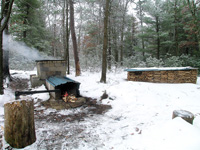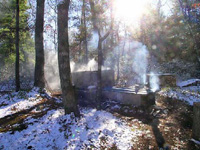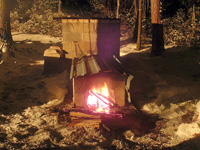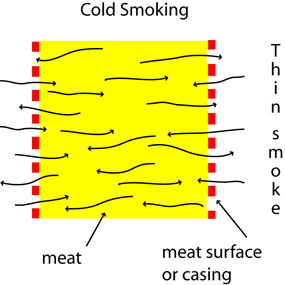Taken from Marianski's forum...
Just read your post as I am new to the forum.
When I hear "cold smoke", to me, that means the temperature never exceeds 70F (ideal temp is around 40F); basically all you want to do is flavor the sausage with the smoke; not cook it. Once smoked the sausage is still raw and must be cooked before eating.
I put my sausage in a 2lb. cloth sack (made for this purpose) and smoke it (using an A-MAZE-N pellet smoker with Hickory pellets) over three or four days or until I get the color I'm looking for (reddish brown) on the outside of the sack. You can do link sausage this way if you use the proper casing.
I monitor the weather/temperature/humidity to assure I'm not going to have a hot (above 70F) day/excessively cold/unusually wet day during smoking. I can only smoke during the winter months, usually middle/late December until early February in my area.
The short answer to your questions is "smoke it until you get the desired flavor". There no specific time period, in my opinion, as there are weather factors that can have an effect on the smoking process.
[h1]Cold Smoking[/h1]
Cold smoking at 52-71° F (12-22° C), from 1-14 days, applying thin smoke with occasional breaks in between, is one of the oldest preservation methods. We cannot produce cold smoke if the outside temperature is 90° F (32° C), unless we can cool it down, which is what some industrial smokers do. Cold smoking is a drying process whose purpose is to remove moisture thus preserving a product.
You will find that different sources provide different temperatures for cold smoking. In European countries where most of the cold smoking is done, the upper temperature is accepted as 86° F (30° C). The majority of Russian, Polish and German meat technology books call for 71° F (22° C), some books ask for 77° F (25° C). Fish starts to cook at 85° F (29.4° C) and if you want to make delicious cold smoked salmon that is smoked for a long time, obviously you can not exceed 86° F (30° C). Cold smoking assures us of total smoke penetration inside of the meat. The loss of moisture also is uniform in all areas and the total weight loss falls within 5-20% depending largely on the smoking time. Cold smoking is not a continuous process, it is stopped (no smoke) a few times to allow fresh air into the smoker.
In XVIII century brick built smokehouses a fire was started every morning. It smoldered as long as it could and if it stopped, it would be restarted again the following morning.

Cold smoked meats prevent or slow down the spoilage of fats, which increases their shelf life. The product is drier and saltier with a more pronounced smoky flavor and very long shelf life. The color varies from yellow to dark brown on the surface and dark red inside. Cold smoked products are not submitted to the cooking process. If you want to cold smoke your meats, bear in mind that with the exception of people living in areas with a cold climate like Alaska, it will have to be done in the winter months just as it was done 500 years ago.



Cold smoking at its best. Smoking continues through the night. Photos courtesy Waldemar Kozik.
Using dry wood is of utmost importance when cold smoking. It is recommended to keep wood chips in a well defined single pile as they will have less contact with air, thus will smoke better without creating unnecessary flames and heat. By following these rules we achieve 75-85% humidity, creating the best conditions for moisture removal. Once the moisture content drops low enough, the salt present in the meat will further inhibit the development of bacteria and the products can hang in the air for months losing more moisture as time goes by.
Lox (smoked salmon) is smoked with cold smoke for an extended period of time. Applying hotter smoke (over 84° F, 28° C) will just cook the fish, the flavor will change and we will not be able to slice it so thin anymore. Cold smoking is a slow process and the hams, which lend themselves perfectly to this type of smoking, can be smoked from 2 to even 6 weeks. During smoking they will slowly be acquiring a golden color along with a smoky flavor.

Cold smoking allows us total smoke penetration inside of the meat. Very little hardening of the outside surface of the meat or casing occurs and smoke penetrates the meat easily.





